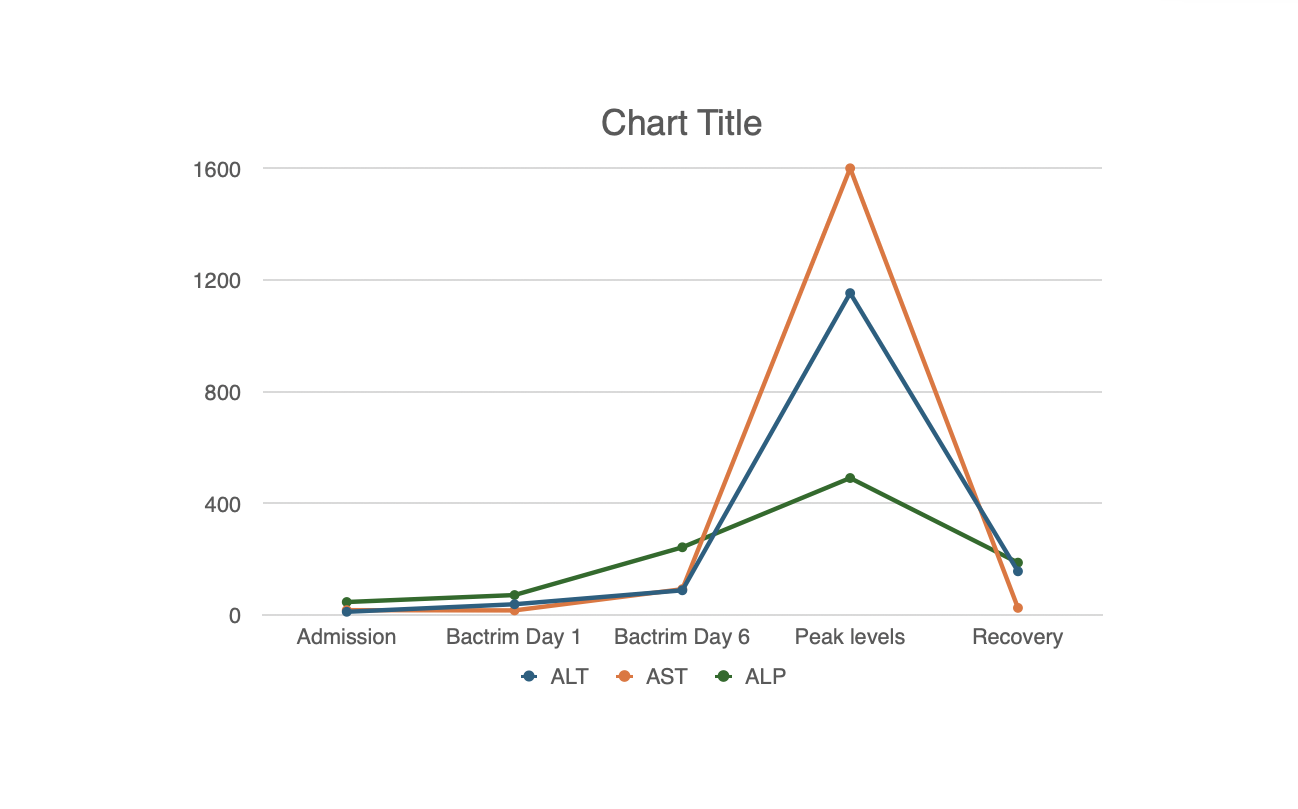Tuesday Poster Session
Category: Liver
P5989 - Steroids and IVIG to the Rescue: A Case of Severe Liver Injury in DRESS Syndrome
Tuesday, October 28, 2025
10:30 AM - 4:00 PM PDT
Location: Exhibit Hall

Mehak Mastoi, MD
One Brooklyn Health-Interfaith Medical Center
Brooklyn, NY
Presenting Author(s)
Mehak Mastoi, MD1, Chidiebele E. Omaliko, MD2, Adedeji Adenusi, MD, MPH1, Derrick Cheung, MD3
1One Brooklyn Health-Interfaith Medical Center, Brooklyn, NY; 2One Brooklyn Health-Brookdale University Hospital Medical Center, Brooklyn, NY; 3Brookdale University Hospital Medical Center, Brooklyn, NY
Introduction: Drug Reaction with Eosinophilia and Systemic Symptoms (DRESS) is a rare and potentially fatal hypersensitivity reaction defined by skin eruptions, hematologic irregularities, and multi-organ involvement, predominantly affecting the liver. Timely identification and immediate intervention are crucial for progression to fulminant liver failure. This case highlights the need to correlate clinical, laboratory, and pathological results to support the diagnosis since a non-specific biopsy and its possible resemblance to other diseases presented diagnostic challenges.
Case Description/
Methods: A 59-year-old male with diabetes, coronary artery disease, and peripheral vascular disease presented with a right groin abscess secondary to an infected pseudoaneurysm. He underwent surgical debridement and started on antibiotics such as Unasyn, vancomycin, and trimethoprim/sulfamethoxazole (TMP-SMX). On the third day of TMP-SMX, he developed a broad, erythematous, desquamating rash affecting the lower extremities, which rapidly advanced to the body, but mentation remained fine throughout
Laboratory examinations showed newly developed eosinophils (23 x 109/L), atypical lymphocytosis, severe transaminitis (AST 1600 U/L, ALT 1153 U/L), total bilirubin 5.8 mg/dL, INR 1.99, anemia, and thrombocytopenia. Extensive evaluation for infectious, autoimmune, and metabolic conditions yielded normal results, except for low-titer positive antinuclear antibody (ANA) and smooth muscle antibody. The skin biopsy revealed interface dermatitis with lymphocytic infiltration but a lack of eosinophils. A RegiSCAR score of 6 established a conclusive diagnosis of DRESS syndrome.
TMP-SMX and vancomycin were discontinued. The patient started on high-dose steroids with IVIG. Within 48 hours, liver enzymes improved; the patient showed clinical improvement.
Discussion: Sulfonamides are found to cause DRESS syndrome, leading to fatal liver damage. Liver involvement requires quick identification and treatment. Lack of eosinophils in skin biopsies emphasizes the importance of clinical judgment and proven scoring systems such as RegiSCAR. As this case demonstrated, effective restoration of liver function thereby supports the use of corticosteroids in resistant or severe situations. Awareness of DRESS-induced hepatitis is crucial as it might resemble viral and autoimmune hepatitis, especially in patients who started on high-risk medications. Timely immunosuppressive treatment with steroids can cause significant recovery and prevent liver failure.

Figure: Trend of liver enzymes following initiation of Trimethoprim/Sulfamethoxazole and improvement upon discontinuation
Disclosures:
Mehak Mastoi indicated no relevant financial relationships.
Chidiebele Omaliko indicated no relevant financial relationships.
Adedeji Adenusi indicated no relevant financial relationships.
Derrick Cheung indicated no relevant financial relationships.
Mehak Mastoi, MD1, Chidiebele E. Omaliko, MD2, Adedeji Adenusi, MD, MPH1, Derrick Cheung, MD3. P5989 - Steroids and IVIG to the Rescue: A Case of Severe Liver Injury in DRESS Syndrome, ACG 2025 Annual Scientific Meeting Abstracts. Phoenix, AZ: American College of Gastroenterology.
1One Brooklyn Health-Interfaith Medical Center, Brooklyn, NY; 2One Brooklyn Health-Brookdale University Hospital Medical Center, Brooklyn, NY; 3Brookdale University Hospital Medical Center, Brooklyn, NY
Introduction: Drug Reaction with Eosinophilia and Systemic Symptoms (DRESS) is a rare and potentially fatal hypersensitivity reaction defined by skin eruptions, hematologic irregularities, and multi-organ involvement, predominantly affecting the liver. Timely identification and immediate intervention are crucial for progression to fulminant liver failure. This case highlights the need to correlate clinical, laboratory, and pathological results to support the diagnosis since a non-specific biopsy and its possible resemblance to other diseases presented diagnostic challenges.
Case Description/
Methods: A 59-year-old male with diabetes, coronary artery disease, and peripheral vascular disease presented with a right groin abscess secondary to an infected pseudoaneurysm. He underwent surgical debridement and started on antibiotics such as Unasyn, vancomycin, and trimethoprim/sulfamethoxazole (TMP-SMX). On the third day of TMP-SMX, he developed a broad, erythematous, desquamating rash affecting the lower extremities, which rapidly advanced to the body, but mentation remained fine throughout
Laboratory examinations showed newly developed eosinophils (23 x 109/L), atypical lymphocytosis, severe transaminitis (AST 1600 U/L, ALT 1153 U/L), total bilirubin 5.8 mg/dL, INR 1.99, anemia, and thrombocytopenia. Extensive evaluation for infectious, autoimmune, and metabolic conditions yielded normal results, except for low-titer positive antinuclear antibody (ANA) and smooth muscle antibody. The skin biopsy revealed interface dermatitis with lymphocytic infiltration but a lack of eosinophils. A RegiSCAR score of 6 established a conclusive diagnosis of DRESS syndrome.
TMP-SMX and vancomycin were discontinued. The patient started on high-dose steroids with IVIG. Within 48 hours, liver enzymes improved; the patient showed clinical improvement.
Discussion: Sulfonamides are found to cause DRESS syndrome, leading to fatal liver damage. Liver involvement requires quick identification and treatment. Lack of eosinophils in skin biopsies emphasizes the importance of clinical judgment and proven scoring systems such as RegiSCAR. As this case demonstrated, effective restoration of liver function thereby supports the use of corticosteroids in resistant or severe situations. Awareness of DRESS-induced hepatitis is crucial as it might resemble viral and autoimmune hepatitis, especially in patients who started on high-risk medications. Timely immunosuppressive treatment with steroids can cause significant recovery and prevent liver failure.

Figure: Trend of liver enzymes following initiation of Trimethoprim/Sulfamethoxazole and improvement upon discontinuation
Disclosures:
Mehak Mastoi indicated no relevant financial relationships.
Chidiebele Omaliko indicated no relevant financial relationships.
Adedeji Adenusi indicated no relevant financial relationships.
Derrick Cheung indicated no relevant financial relationships.
Mehak Mastoi, MD1, Chidiebele E. Omaliko, MD2, Adedeji Adenusi, MD, MPH1, Derrick Cheung, MD3. P5989 - Steroids and IVIG to the Rescue: A Case of Severe Liver Injury in DRESS Syndrome, ACG 2025 Annual Scientific Meeting Abstracts. Phoenix, AZ: American College of Gastroenterology.
